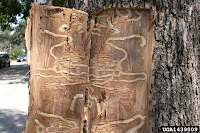Aug. 10, 2010
Emerald Ash Borer Quarantine Expanded to 43 Counties; Tree-Killing Pest Found in Cumberland, Union Counties
Harrisburg – Forty-three counties are now under a quarantine that is intended to prevent the spread of the invasive, tree-killing Emerald Ash Borer, Agriculture Secretary Russell C. Redding said today while reminding travelers not to haul firewood between counties.
Redding also said that the pest has been found in two additional counties. Beetles were found in Cumberland County at the Pennsylvania Turnpike mile marker 226 near Carlisle, and in Union County at the intersection of State Gameland and Matthew Brown roads in Gregg Township.
The Emerald Ash Borer has now been found in 17 counties: Allegheny, Armstrong, Beaver, Bedford, Butler, Centre, Cumberland, Fulton, Indiana, Juniata, Lawrence, Mercer, Mifflin, Somerset, Union, Washington and Westmoreland.
The Agriculture Department has expanded its quarantine to include 31 counties, including the six where the beetle has been found this year and others that are contiguous. Those counties are: Blair, Cambria, Cameron, Centre, Clarion, Clearfield, Clinton, Columbia, Crawford, Cumberland, Elk, Erie, Fayette, Forest, Franklin, Fulton, Greene, Huntingdon, Jefferson, Lycoming, McKean, Montour, Northumberland, Perry, Potter, Snyder, Somerset, Tioga, Union, Venango and Warren.
“The considerable quarantine expansion was based on the new detections, coupled with new detections and quarantines in neighboring states,” said Redding. “As we head into the final months of summer travel, we remind campers and travelers to follow the quarantine within the 43 counties and across the state to help limit the further spread of the beetle.”
The quarantine is intended to restrict the movement of ash nursery, green lumber, and any other ash material, including logs, stumps, roots and branches, from the quarantine area. Because it is difficult to distinguish between species of hardwood firewood, all hardwood firewood and wood chips—including ash, oak, maple and hickory—are considered quarantined.
Redding said Emerald Ash Borer poses a serious threat to Pennsylvania’s nation-leading hardwoods industry, which contributes nearly $25 billion to the economy.
The wood-boring beetle is native to China and eastern Asia. The pest likely arrived in North America in wooden shipping crates. It was first detected in July 2002 in southeastern Michigan and neighboring Windsor, Ontario, Canada. In addition to Pennsylvania, the beetle is attacking ash trees in Illinois, Indiana, Iowa, Kentucky, Maryland, Michigan, Minnesota, Missouri, New York, Ohio, Tennessee, Virginia, West Virginia and Wisconsin.
Typically, the Emerald Ash Borer beetles will kill an ash tree within three years of the initial infestation. Adults are dark green, one-half inch in length and one-eighth inch wide, and fly only from early May until September. Larvae spend the rest of the year beneath the bark of ash trees. When they emerge as adults, they leave D-shaped holes in the bark about one-eighth inch wide.
People who suspect they have seen Emerald Ash Borer should call the department’s toll-free pest hotline at 1-866-253-7189. For more information about the quarantine, contact Walt Blosser at 717-772-5205, and for more information about Emerald Ash Borer, contact Sven-Erik Spichiger at 717-772-5229.
The Agriculture department’s Emerald Ash Borer survey crews began hanging nearly 6,000 purple panel traps from ash trees in 21 counties on May 21. The traps are designed to attract flying adult beetles to help detect further spread.
The national survey is conducted in cooperation with U.S. Department of Agriculture’s Animal and Plant Health Inspection Service, the United States Forest Service, and the Pennsylvania Department of Conservation and Natural Resources’ Bureau of Forestry.
Information is also available at www.agriculture.state.pa.us by searching “Emerald Ash Borer.”
 The 2011 Woodland Owners Conference will be held Saturday, March 5 in Penn’s Inn, Bush Student Center on the campus of the Pennsylvania College of Technology in Williamsport. The tentative agenda for the conference is:
The 2011 Woodland Owners Conference will be held Saturday, March 5 in Penn’s Inn, Bush Student Center on the campus of the Pennsylvania College of Technology in Williamsport. The tentative agenda for the conference is:







